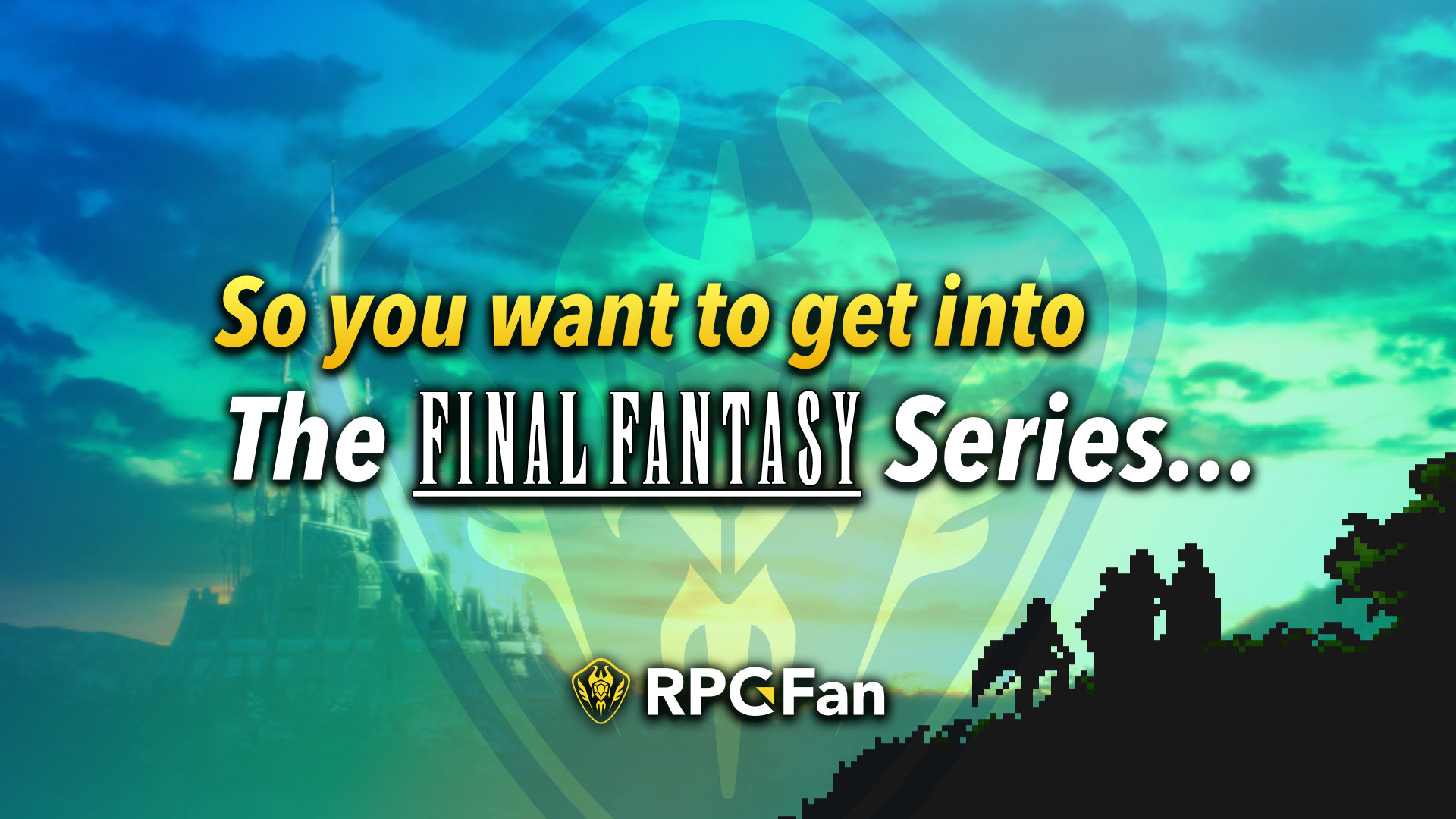To call Final Fantasy a titan of the RPG world is a profound understatement. For many, it is the RPG series. For many others, it used to be. Some consider it a home for tradition, others an experimental playground. It’s a series that’s as divisive as any, but one that nonetheless keeps breaking sales records and posting success after success. But with 15 mainline games to date, the only type of fan left behind in the discussion is the non-fan.
As such, this guide is for the newbie. I’ll be walking through the 15 mainline games, including information on what makes them unique, what you might and might not like, and the best ways to play each one today. But let’s assume you’re completely fresh. You’ve never heard about Final Fantasy, and you’re trusting me to be your shepherd.
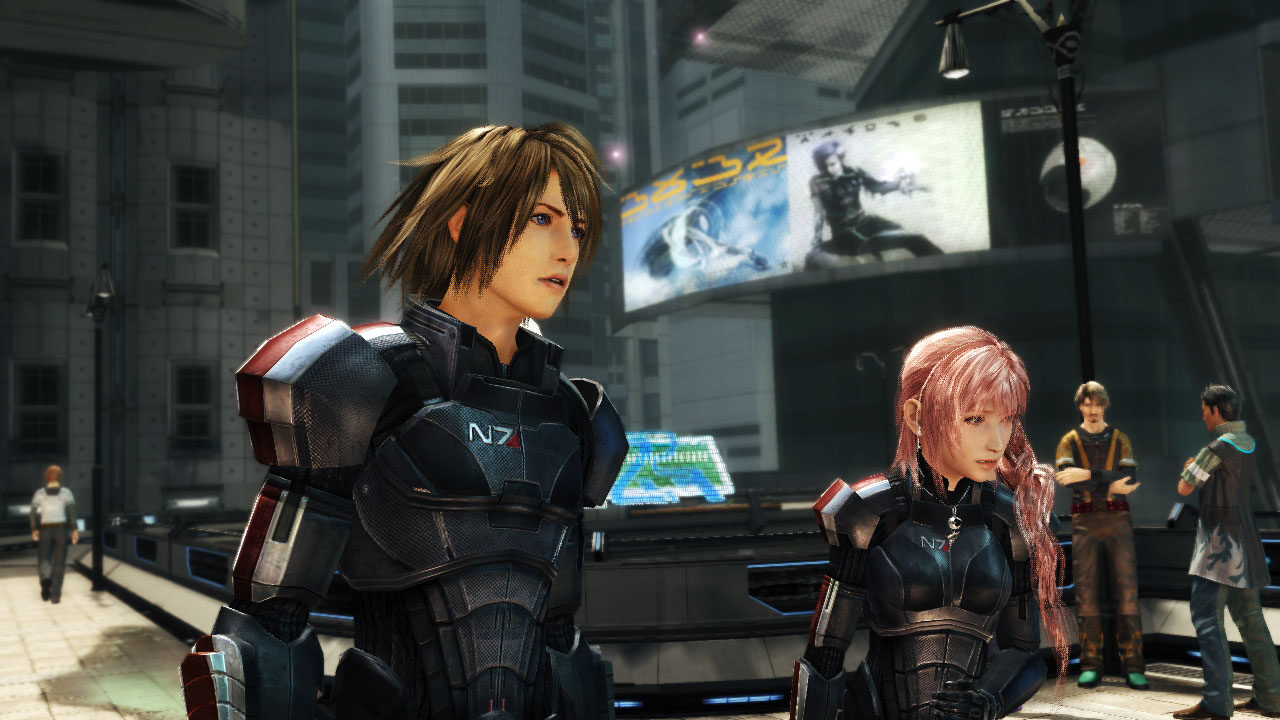
First off, fantastic choice. I’m a great shepherd. I’ve got two kids, and they’re… I mean, they’re fine. Usually.
Second, let’s get the basics down: Final Fantasy is an RPG series made by Square Enix, previously held by the Squaresoft half of that company. While it started as a series of turn-based RPGs (basic by today’s standards but groundbreaking in its time), Final Fantasy has evolved through dozens of spinoffs to hit just about every genre you can imagine. From fighting games to rhythm games, from shooters to racing games, Final Fantasy is enough of a global phenomenon to sell copies on name recognition alone. That said, RPG fans occupy a niche market to this day.
Final Fantasy is often at the forefront of the genre and has never been afraid to reinvent itself, even within the mainline series. While this brings mixed reactions from many of the series’ longtime fans, it ultimately means that any given game might be the best point to dive in. But with this constant reinvention, what really defines Final Fantasy is a pretty open question. Those that were in it for the core gameplay tenets started falling off around Final Fantasy X and XI. Those looking for a fantasy setting fell off as early as Final Fantasy VI. There’s plenty of history to dig into, but there are ample resources on that, so let’s hit what I consider the core building blocks of a mainline Final Fantasy game.
- RPG – To some degree or another, every mainline Final Fantasy is a role-playing game. While the gameplay itself might vary wildly and the amount of player control over the plot is generally limited, the games always feature character progression and a strong focus on story. This means leveling up, finding new gear, unlocking new abilities, and immersing yourself in a somewhat linear story packed with unique characters and fantasy world-building.
- (Melo)drama – The Final Fantasy series is known for its dramatic chops, which fans may categorize anywhere from “awe-inspiring” to “embarrassingly melodramatic.” Wherever you fall on the spectrum, the series usually focuses strongly on characters and interpersonal drama before dovetailing into gigantic world-level stakes. Games may vary in how seriously they take themselves, as earlier games were often a bit lighter. But, compared to other games released at the time, Final Fantasy usually took itself far more seriously and demanded that players invest themselves in the world.
- Technology – Final Fantasy usually sets the audiovisual standards for RPGs when they release. They are generally well ahead of the competition for visual fidelity, and its stable of veteran composers (especially Nobuo Uematsu, who was with the series during its formative years and through its heyday) have created some of gaming’s most iconic tracks. Final Fantasy is often seen as an RPG for non-fans of the genre, as it offers AAA production value in a genre known for working on tighter budgets.
- Standalone experiences – While some games have gotten direct sequels over the years, most Final Fantasy games take place in separate universes with unconnected plots. No mainline Final Fantasy games directly tie into each other outside a few fan theories. So, no matter what mainline game you choose to play first, you won’t be behind on the story and will be able to experience the entirety of the experience with no prior knowledge.
- Iconography – Finally, the series can always be identified by the nods to longtime fans. Whether it’s series staple monsters like chocobos and moogles or essential music like the Prelude, Final Fantasy includes plenty of references to the series’ history while ensuring they all fit into the world of each independent game. While not every game features every icon, you can generally expect to ride a chocobo, cast some black magic, or run into a grizzled engineer named Cid in most games.
Whew! That’s a lot to start. But we’re about to go even deeper, as we hit every single mainline Final Fantasy game in order.
Final Fantasy
Original Release: 1987, Nintendo Famicom (NES)
Also Released On: Sony PlayStation, Sony PSP, WonderSwan Color, Mobile, Nintendo Game Boy Advance, Nintendo 3DS, Nintendo Wii, Nintendo Wii U, NES Classic Edition, Microsoft Windows, Android, iOS
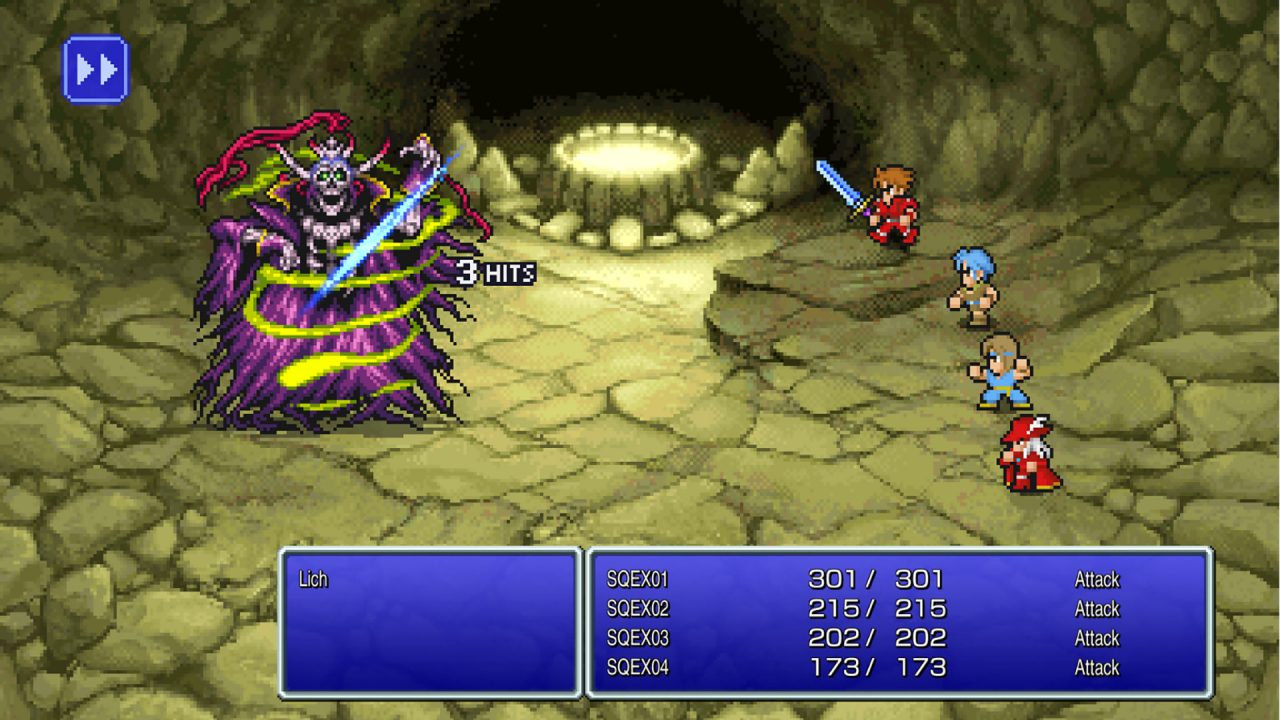
What it’s about: Final Fantasy is a basic story about four youths, chosen by glowing Orbs (or Crystals, as series translations would later adopt) who seek to save the world from initially ambiguous capital-D Darkness. While the plot is fairly simple for today, it took twists as the game progressed that gave it some novel elements of sci-fi that would not only introduce concepts rare in a fantasy RPG, but would inform the design of series titles for years to come.
How it plays: Final Fantasy is a traditional turn-based RPG wherein you input commands for your party and then watch as the actions of your party and enemies play out. Outside combat, you’ll explore the world and find towns with people to talk to, treasure-filled dungeons to explore, and plenty of bosses to progress the story. At the beginning of the game, you create four characters from a few series staple jobs, giving longtime fans ample replay as they experiment with interesting and sometimes ineffective combinations of jobs and see what it takes to beat the game.
What it brought to the series: Most obviously, it kickstarted the series. As the bedrock the rest of Final Fantasy was built on, the elements presented here are the most commonly used throughout the rest of the series. The focus on elemental crystals would be revisited time and again. A few recurring enemies debut here, such as the series take on the simple goblin. The game’s villain, Garland, would be referenced regularly throughout the series, though each iteration is generally a new character. Also introduced are series mainstay dragon Bahamut and a host of jobs: Warrior, Monk, Thief, White Mage, Black Mage, and Red Mage. The game also allowed you to take to the skies with the first of the series’ standard travel method, airships.
Why you might like it: Final Fantasy offers great historical context—seeing where many of the series’ defining elements debut can be a wonderful experience and conjure up nostalgic feelings for the era even if you don’t have memories of this exact game. The party creation adds some fun replayability, as unique party combinations make the game feel reasonably different. Final Fantasy gives you some classic gameplay that was at the top of its class for its time.
Why you might not: The game has aged heavily. The plot is pretty basic, lacking any significant character development. The core gameplay mechanics are nothing you haven’t seen over the past 35 years, and many elements that make up modern Final Fantasy weren’t present yet. If you play the original release, you’ll have yet more to wrestle with, as it uses an older MP system that has since fallen out of fashion. Finally, battles go without modern targeting—if you kill an enemy, the next character who targeted that enemy will just attack air. Don’t worry, rereleases help with these more archaic leftovers.
Which version to play: There are a lot of options with this one. The most complete version is Final Fantasy Anniversary Edition for the PSP, available for play on the Vita by purchasing through the PlayStation Store. The recent Final Fantasy Pixel Remaster offers a capable version of the original title, though your mileage may vary based on available platforms (as of this writing, the Pixel Remasters are only on Windows, iOS, and Android), questionable font choices, and how highly you value the added content from other versions not included in the remasters. Failing that, the PSOne and Game Boy Advance versions feature the updates required to make Final Fantasy a more or less modern experience, updating the magic system, game balance, interface, world map controls, and battle oddities. The original NES version is only recommended if you really want to delve into the series’ history. You’re nearly guaranteed a better time with one of the ports if you’re a newcomer to the game.
Final Fantasy II
Original Release: 1989, Nintendo Famicom (NES)
Also Released On: Sony PlayStation, Sony PSP, WonderSwan Color, Nintendo Game Boy Advance, Nintendo Wii, Nintendo Wii U, Microsoft Windows, Android, iOS
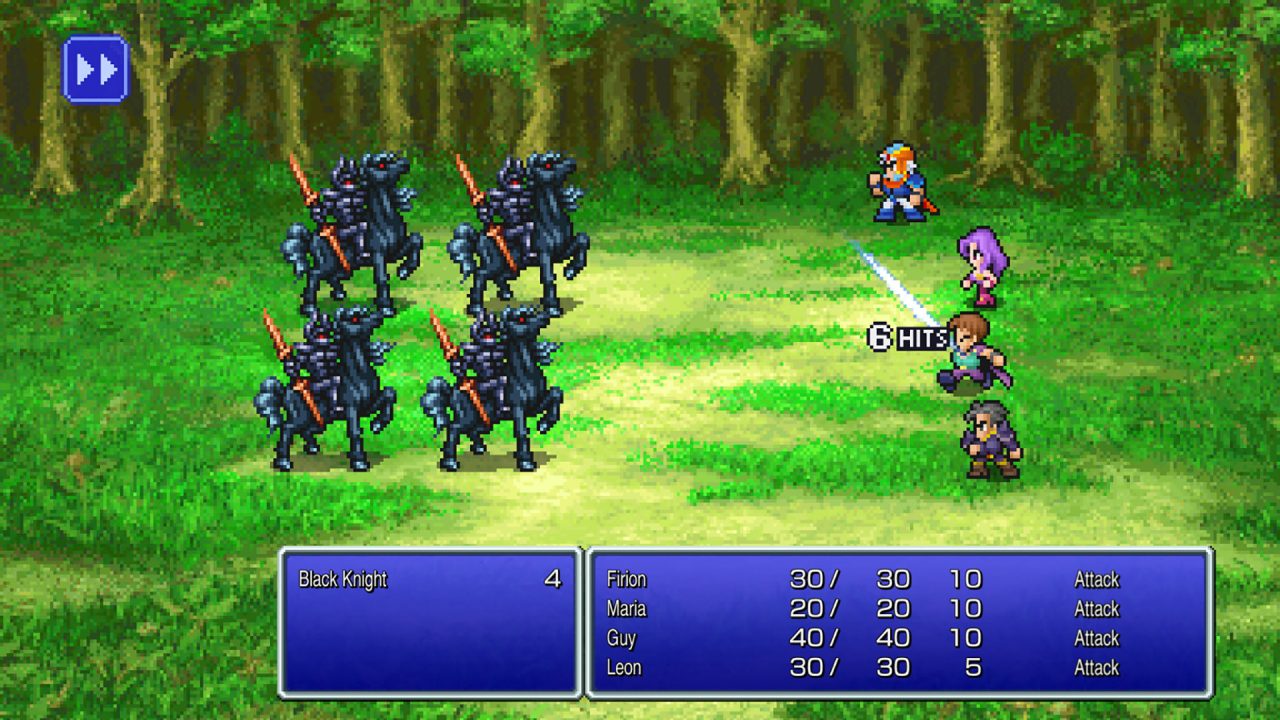
What it’s about: Final Fantasy II is the first game in the series that stars named playable characters with their own personalities, desires, and roles in the world. The game opens as four friends flee their village as a standard issue evil empire burns it to the ground and orphans the young heroes. As you travel the world, attempting to take down the Emperor, you’ll control three of the childhood friends (Firion, Maria, and Guy) with a rotating character occupying your fourth slot. This system allows these fourth characters to often drive the story, and those characters can join and leave the party for many different reasons. While the series would go back to blank-slate characters once more in Final Fantasy III, the trend of stories with characters at their core started here and became a hallmark of the series going forward.
How it plays: Battles, world exploration, and equipment progression follow pretty directly from Final Fantasy. FFII features a keyword system that requires you to memorize specific words and use them on characters to unlock extra dialogue. However, the most significant change in Final Fantasy II is the leveling system. Rather than having traditional levels, characters in Final Fantasy II improve through skill use. If you use physical attacks more, your strength will improve. You’ll gain HP as you take damage and magical power as you cast spells. This system offers more organic character growth and gives you a high degree of customization over your characters, as you can mold each character into any archetype you choose. Whether or not the system works in practice is still a point of contention to this day.
What it brought to the series: Final Fantasy II brought many Final Fantasy traditions to the series. Chocobos, the signature bird mount of the series, make their first appearance here. We also get the first appearance of Cid, a name given to different characters in each game, often associated with an engineer of some kind. The set characters and story focus of Final Fantasy II persisted throughout the series, forming the foundation of the series to this day. Several jobs also make their first appearance here, including the fan favorite Dragoon—a dragon knight associated with spears, combat jumping, and stylish armor.
Why you might like it: Final Fantasy II offers one of the best examples of storytelling of its time. While the plot is pretty routine by today’s standards, playing an epic with a rotating (and mortal) cast that stretches across so many locations is exciting, as is witnessing the origins of both chocobos and Cid. The game also offers quite a few curiosities that appeal to those who love novelty, from its leveling system to the keywords required for progression.
Why you might not: For many fans, Final Fantasy II sits at or near the bottom of the ranking. The leveling system doesn’t scale well, often leading to extended leveling sprees where you do things like attacking your own party to drive your HP up for the next boss. The keyword system is usually more annoyance than gameplay mechanic, acting as an unnecessary barrier to plot progression. The game also frustrates through lack of clarity. For example, the last boss can be incredibly difficult if you sell your Blood Swords. Unfortunately, these are mid-game swords that are outclassed by the end game, but their HP absorbing effect is nearly required for the last boss unless you’ve invested significant time into powering up your team.
Which version to play: Final Fantasy II has about as many versions as the first game. The two were bundled together in many cases, such as on PSOne and GBA. As such, recommendations are similar to those for Final Fantasy: the PSP version is generally regarded as the best, and the Pixel Remaster is solid with the same caveats as the original. The PSOne version is available on the PlayStation Store, though it has extra load times. The original NES version is only available via fan translation and, again, primarily recommended to history buffs.
Final Fantasy III
Original Release: 1990, Nintendo Famicom (NES)
Also Released On: Sony PSP, Nintendo DS, Nintendo 3DS, Nintendo Wii, Nintendo Wii U, NES Classic Edition, Microsoft Windows, Android, iOS
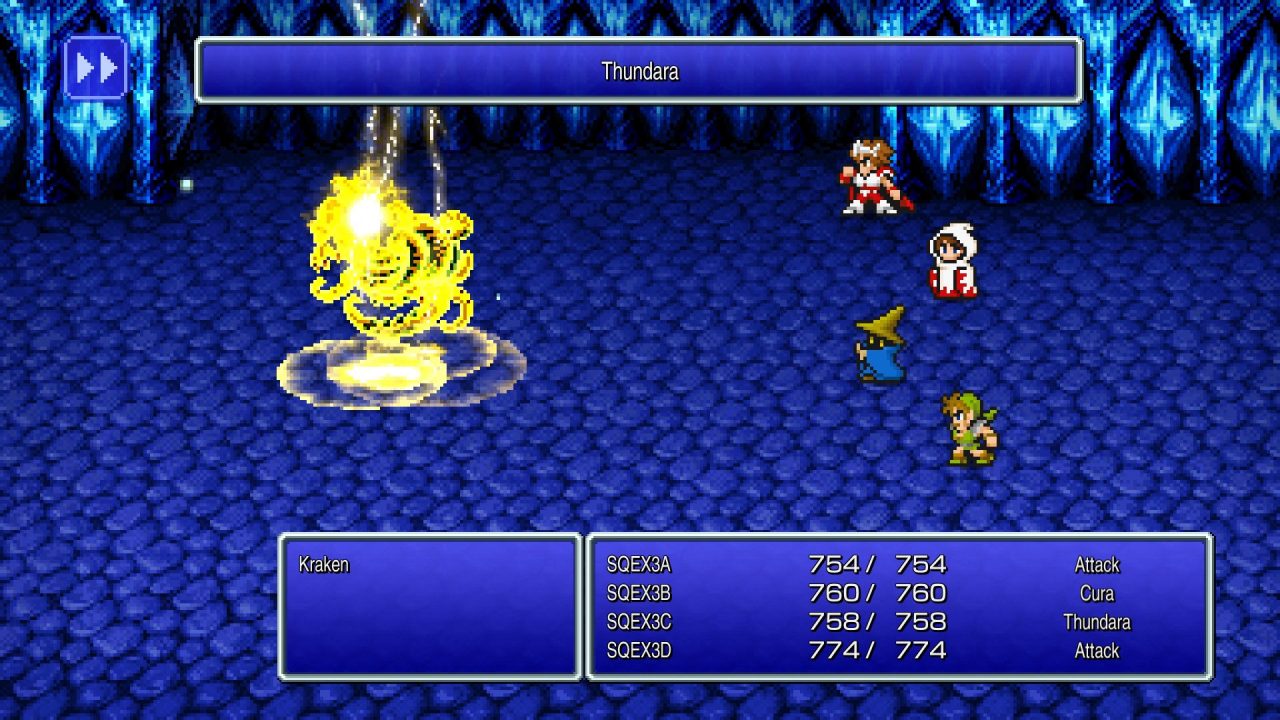
What it’s about: Final Fantasy III marks a return to generic characters, this time a quartet of orphans that quickly find a crystal that grants them power marking them as Warriors of Light tasked with returning light to the world. While the crew starts as lowly Onion Knights, the crystals give the warriors the ability to change jobs through various iconic roles in the series, some appearing for the first time. As is tradition, the warriors face an evil empire led by Emperor Xande and must stop his machinations while uncovering the power behind the throne. Interestingly, the generic cast was replaced by distinct characters with actual personalities in the 3D remake, adding a layer of growth to the story.
How it plays: While the core combat and exploration style continues from previous titles, the biggest change in Final Fantasy III is, without a doubt, the debut of the job system. While your characters are blank slates, sticking with a job makes them better at that job (and makes it less costly for them to change back and forth from it), making specialization advantageous. Figuring out which jobs are good, which ones are bad, and which ones utterly break the game is key to beating some of the more challenging bosses at the end of the game. Status effects take a larger role, as some dungeons even require using status effects such as Mini to navigate small spaces. Jobs are further enhanced by unique commands in battle and special effects in the field, such as the thief’s ability to open locked doors.
What it brought to the series: The job system quickly became a mainstay of the Final Fantasy series in one form or another. But that’s not all we got! Moogles, one of the most beloved mascots in the franchise, first appeared here in Final Fantasy III. Unique job abilities like stealing or, more iconically, the Dragoon’s jump ability, originated here. Summoned creatures joined the fray for the first time, a feature that would persist throughout the series, often becoming the focus of Final Fantasy stories. Final Fantasy III is one of the most popular entries with series vets in Japan, most prominently visible as the basis for the entire Crystal Tower raid series (and more) in Final Fantasy XIV.
Why you might like it: Managing jobs is extremely satisfying. From unique sprites to experimenting with job commands, the amount of customization available to your party is unique to its time. There are plenty of historical reasons to play Final Fantasy III, but few more prominent than experiencing the oft-referenced story beats of the series’ third outing. And in addition to the origins of moogles, you can enjoy an incredible soundtrack that still gets musical references and arrangements in Final Fantasy games to this day.
Why you might not: To be honest, Final Fantasy III occupies a space similar to Final Fantasy II for many English-speaking fans. A victim of arriving long, long after its initial release in the West, the game feels incredibly dated. High random encounter rates, enemies with instant-death abilities, and long slog dungeons without save points lead to much tedium and lost progress. It can be a frustrating experience.
Which version to play: The recently released Final Fantasy III Pixel Remaster is probably the easiest way to work through the game. Autosaves help with the lack of dungeon save points, and the game overall is just a touch easier, which is pretty necessary considering the harsh difficulty of the base game. The DS remake (also available on mobile and PC) introduces a bit of texture to the story, but it maintains the original’s rough edges and comes with its own UI and bug issues. If you want to return to the originals, you’ll need a strong constitution.
Final Fantasy IV
Original Release: 1991, Super Famicom (SNES)
Also Released On: Nintendo Game Boy Advance, Sony PlayStation, Sony PlayStation 3, Sony PSP, Sony PS Vita, WonderSwan Color, Nintendo DS, Nintendo Wii U, Microsoft Windows, Android, iOS
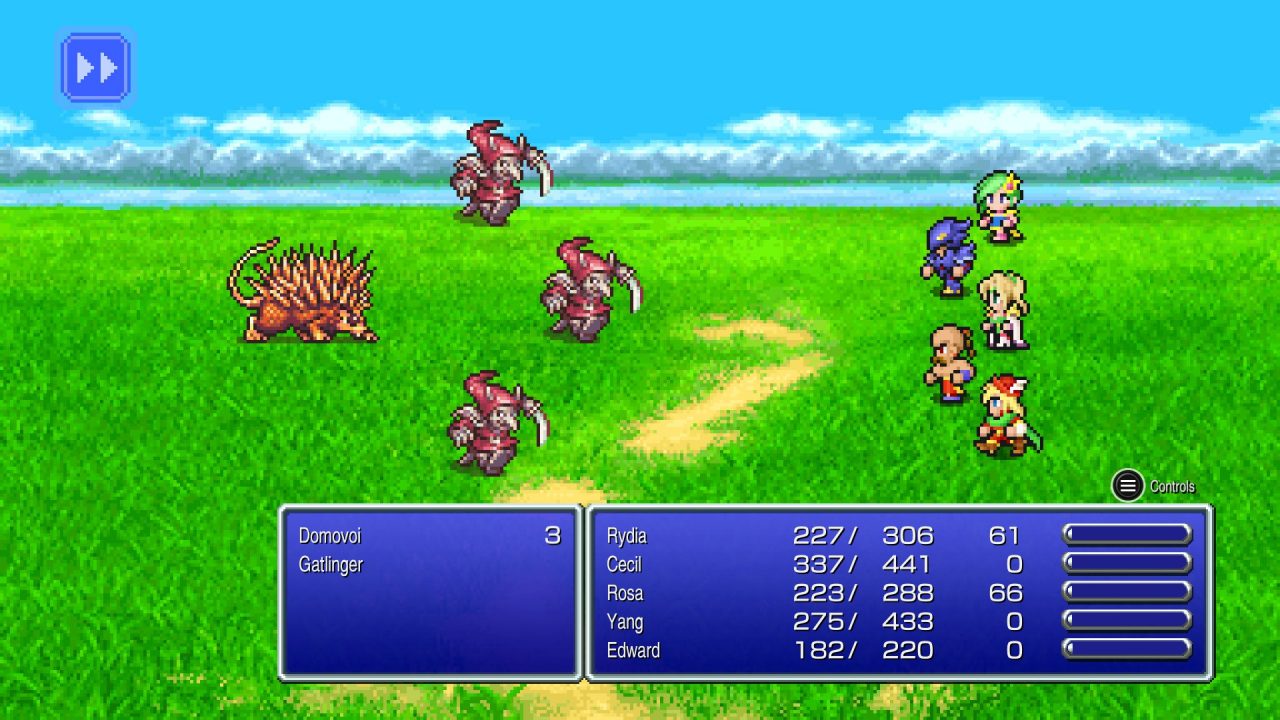
What it’s about: Final Fantasy IV stars Cecil, a dark knight in the service of the evil empire of the day. The tasks he’s asked to carry out get less and less morally excusable, leading to a crisis of faith as Cecil is forced to reckon with his past, redeem himself, and of course, save the world. Along for the ride are some of the most recognizable characters in the series’ history, who come and go as the story dictates. For the most part, each of these characters have complete character arcs, none of which detract from a story that leads the heroes around the world—and beyond.
How it plays: The series’ staple Active Time Battle system debuts in FFIV, with characters acting based on an invisible counter (which would become visible in later versions of the game). Once a character’s timer fills up, they get to act, making faster characters a bit more valuable as they can use more actions than slower enemies. This is where most of the depth lies. Each character takes on a classic Final Fantasy job, which is fixed for the whole game. While this makes characters feel unique in battle, this leaves little customization outside of equipment. Your ninja Edge will always throw weapons, while summoner Rydia… well, she summons. Otherwise, expect a pretty linear classic RPG focusing on story.
What it brought to the series: The ATB system is still iterated upon to this day, making it one of the most essential gameplay elements of the venerable series. Iconic characters tied to jobs define the look of those jobs to this day, with every Dragoon in Final Fantasy XIV going through several Kain phases throughout their life. The structure of Final Fantasy IV also broke from the standard loop between dungeons and towns, making for a more cinematic experience where setpieces could be strung together without intervening periods on the world map or in dungeons. This would impact the entire series going forward.
Why you might like it: Final Fantasy IV has one of the most standout stories in the series, which is easily the greatest draw of the game. The characters are wonderful to get to know, and each feels unique both in battle and out. In addition, the gameplay is no slouch, as the traditional trappings are kept interesting by a rotating party with unique abilities. This keeps the journey interesting, even without a plot that takes regular wild twists and turns.
Why you might not: In some ways, Final Fantasy IV’s status as the standard for the series also means it doesn’t do much unique (in hindsight). It executes everything it does well, but aside from the story, there’s not much here that other games haven’t copied and iterated on in the years since. Some of the relics of the past can be rough for modern players, with high random encounter rates meeting occasional difficulty spikes. It’s a game that’s hard to hate, but isn’t always easy to love.
Which version to play: Really, there are two flavors of FFIV: 2D and 3D. The 2D versions mostly have plenty in common, with Final Fantasy IV: The Complete Collection on PSP being the easiest to recommend, but any version aside from the original US SNES release will give you a solid experience. The initial US release ditched a lot of items, character abilities, and mechanics to make the game easier for a Western audience that was perceived as less experienced with the genre than their Japanese counterparts. The 3D version is a different beast. Originally released on DS and later ported to mobile and PC, the 3D version adds a few layers of customization, including skills you can add to any character’s repertoire. The visual facelift is about on par with a PlayStation-era title and includes full voiceover and cinematics. It can feel like a more modern game, but the difficulty is also a bit higher than the original. While the aforementioned changes help the game feel more modern, they also lose a bit of the charm of the original in the transition. Still, it’s hard to go wrong no matter which you play… aside from the SNES original.

